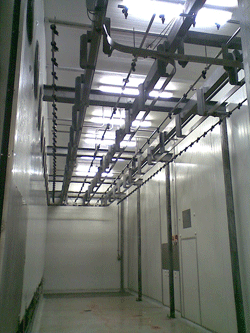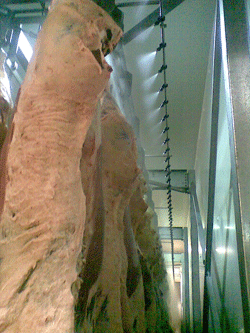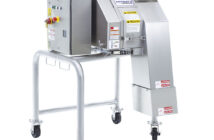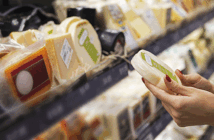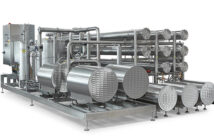Spray chilling is the intermittent spraying of carcasses with water during the early stages of the cooling of hot sides. Spray chilling has been shown to reduce weight loss during overnight chilling.
Research by Spraying Systems Co has shown the reduction of weight loss (shrink) of up to two percent due to evaporation of moisture from the surface tissue.
In 2011 the Australian industry produced close to 2.1 million tonnes of beef and veal. Using an average beef sales price of A$5.06 per kilogramme, this is a cost to the industry of evaporative losses of between A$106.3 million and $212.5 million in beef and veal sales alone. If we were to add lamb, pork other red meats and poultry the figure is staggering.
Spraying Systems Co has developed and successfully installed systems in Australia that have added value not only in savings but have delivered a return on the original investment of A$1 million by returning A$4 million payback on the original investment in the first year.
How does spray chilling work
The standard chilling process uses circulating cold air to cool hot carcasses by passing cold air over the carcass, thus evaporating surface moisture. As the cooling process continues and surface moisture has been evaporated, deeper tissue is cooled as moisture is drawn to the surface.
The evaporation is rapid in the initial stages as there is a large difference between the hot carcass temperature and the chiller air temperature. The evaporation causes carcass shrinkage, which is the moisture/weight lost by the carcass due to the chilling process.
Spray chilling uses sprays of water to offset the evaporative loss of carcass chilling. Sprayed water is then evaporated from the carcass and moisture is not drawn from deeper in the tissue. Timing of sprays and amount of water sprayed is key to get the shrinkage as close to zero as possible. Shrinkage and carcass chilling are also influenced by other variables; including but not restricted to – chiller design, operating conditions, carcass size and carcass fat cover.
Typical operation
Cooling the carcass with air draws moisture from the surface of the carcass initially and then from the inner carcass as the cooling process progresses. When air velocities around the chiller are increased to accelerate the cooling process it increases moisture and weight loss.
The additional moisture on the surface of the carcass becomes sacrificial. So by spraying water to the carcass surface it is sacrificed in favour of natural carcass moisture thereby preserving moisture in the carcass and preventing further carcass weight loss during cooling process.
Refrigerated air becomes low in humidity as it moves through the heat exchanger.
Dry air attracts moisture as it removes the residual heat from the carcass. The moisture loss is also a function of cooling and carcass weight loss occurs through this moisture evaporation.
Spraying chilled water at three degrees Celsius has a more instant cooling effect on the carcass. This speeds up the cooling of the carcass core temperature. Carcasses retain moisture and therefore body weight.
www.spray.co.nz


























































































